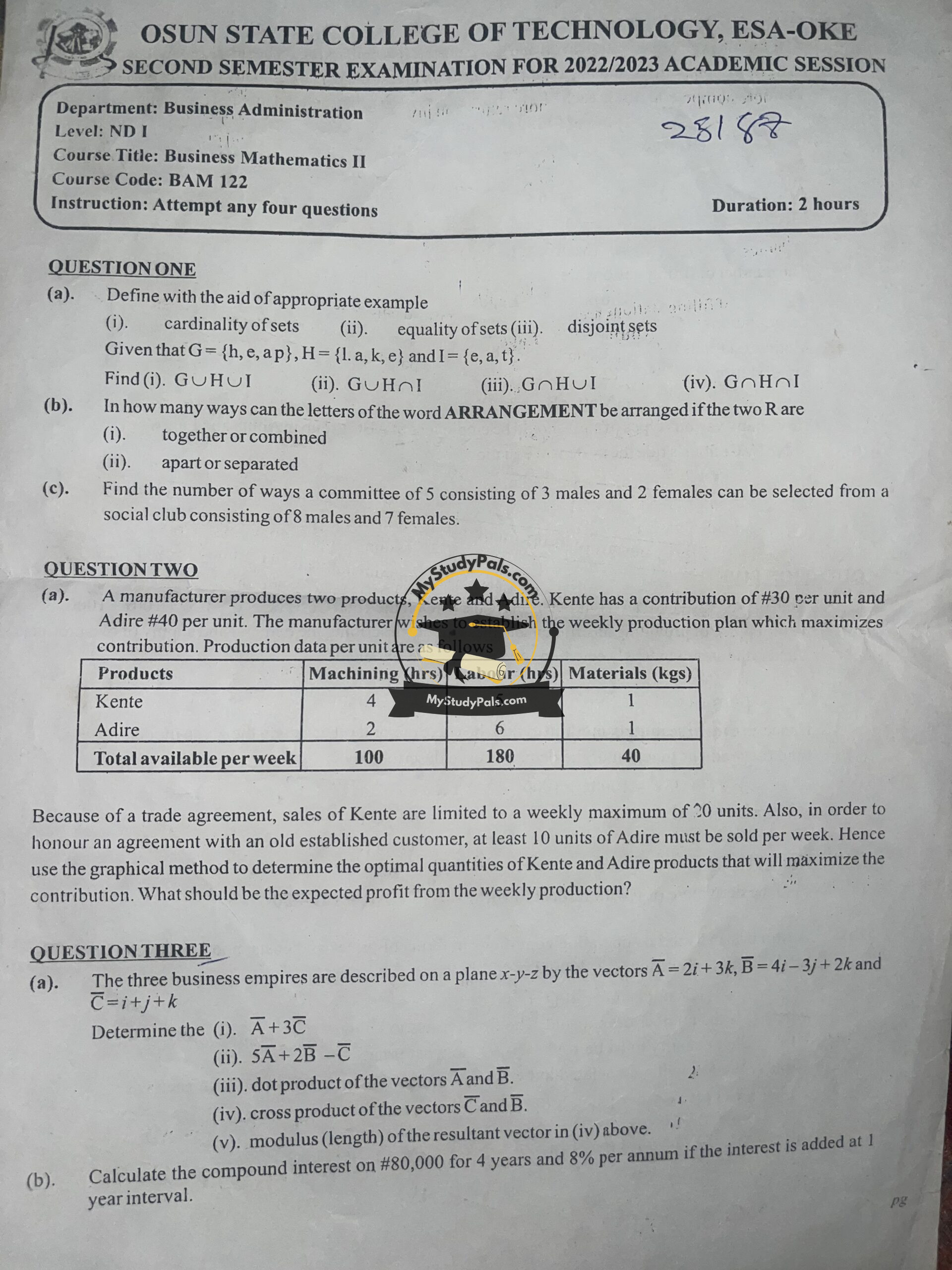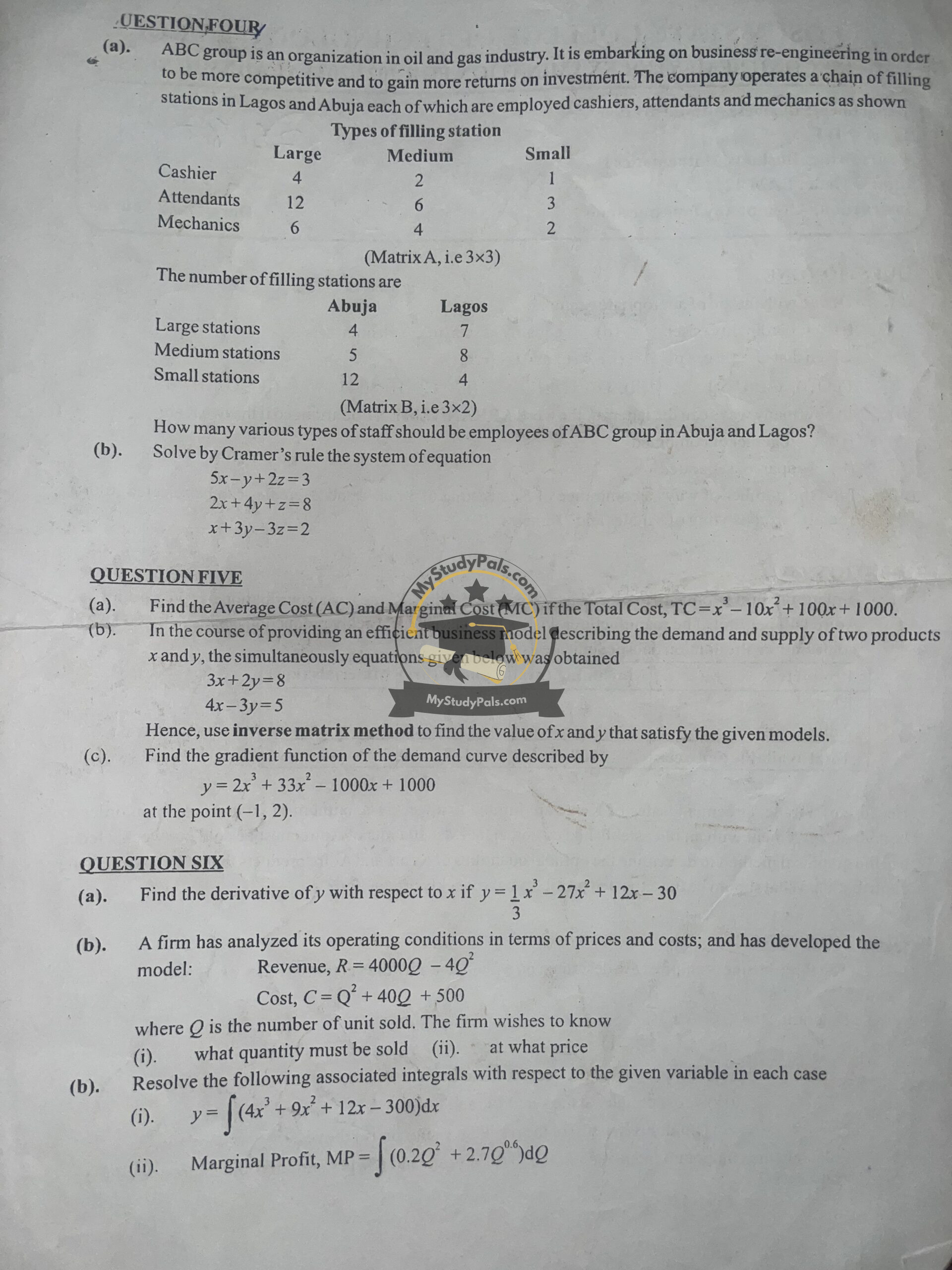ANSWER
Here are the answers to the exam questions in the requested format:
Question 1:
(a) Definitions with Examples
(i) Cardinality of sets: The number of elements in a set. Example: If A = {1,2,3}, then |A| = 3.
(ii) Equality of sets: Two sets are equal if they contain the same elements. Example: A = {1,2,3} and B = {3,2,1} are equal.
(iii) Disjoint sets: Two sets are disjoint if they have no common elements. Example: A = {1,2,3}, B = {4,5,6}.
(b) Set Operations
Given G = {h, c, a, p}, H = {l, a, k, e}, I = {e, a, t}
(i) G∪H∪I={h,c,a,p,l,k,e,t}G \cup H \cup I = \{h, c, a, p, l, k, e, t\}
(ii) G∪H∩I={h,c,a,p,l,k,e}G \cup H \cap I = \{h, c, a, p, l, k, e\}
(iii) G∩H∪I={a,e,t}G \cap H \cup I = \{a, e, t\}
(iv) G∩H∩I={a}G \cap H \cap I = \{a\}
(c) Arrangements of “ARRANGEMENT”
(i) When R’s are together: Consider “RR” as a unit, so we arrange “ARRANGEMENT” as 10 letters with “RR” as one. The formula:
10!2!2!2!=36288008=453600\frac{10!}{2!2!2!} = \frac{3628800}{8} = 453600
(ii) When R’s are apart: Total arrangements – cases where R’s are together.
(d) Selecting a committee of 5 from 8 males and 7 females
Choosing 3 males: (83)=8!3!(8−3)!=56\binom{8}{3} = \frac{8!}{3!(8-3)!} = 56
Choosing 2 females: (72)=7!2!(7−2)!=21\binom{7}{2} = \frac{7!}{2!(7-2)!} = 21
Total ways = 56×21=117656 \times 21 = 1176
Question 2:
(a) Maximizing Contribution using Graphical Method
Objective function: Z=30x+40yZ = 30x + 40y
Constraints:
4x+2y≤1004x + 2y \leq 100
5x+6y≤1805x + 6y \leq 180
x+y≤40x + y \leq 40
x≤20x \leq 20, y≥10y \geq 10, x,y≥0x, y \geq 0
(Solve graphically and find maximum ZZ)
Question 3:
(a) Vector Operations
Given:
A=2i+3kA = 2i + 3k, B=4i−3j+2kB = 4i – 3j + 2k, C=i+j+kC = i + j + k
(i) Aˉ+3Cˉ=(2+3)i+(0+3)j+(3+3)k=5i+3j+6k\bar{A} + 3\bar{C} = (2 + 3)i + (0 + 3)j + (3 + 3)k = 5i + 3j + 6k
(ii) 5Aˉ+2Bˉ−Cˉ5\bar{A} + 2\bar{B} – \bar{C}
(iii) Dot product A⋅B=(2)(4)+(0)(−3)+(3)(2)=8+0+6=14A \cdot B = (2)(4) + (0)(-3) + (3)(2) = 8 + 0 + 6 = 14
(iv) Cross product:
A×B=∣ijk2034−32∣=(−9i+8j−6k)A \times B = \begin{vmatrix} i & j & k \\ 2 & 0 & 3 \\ 4 & -3 & 2 \end{vmatrix} = (-9i + 8j – 6k)
(v) Modulus: (−9)2+82+(−6)2=81+64+36=181\sqrt{(-9)^2 + 8^2 + (-6)^2} = \sqrt{81+64+36} = \sqrt{181}
(b) Compound Interest
A=P(1+r/n)ntA = P(1 + r/n)^{nt}
A=80,000(1+0.08/1)4=80,000(1.08)4A = 80,000(1 + 0.08/1)^4 = 80,000(1.08)^4
A=108,262.4A = 108,262.4
CI = 108,262.4−80,000=28,262.4108,262.4 – 80,000 = 28,262.4
Question 4:
(a) Matrix Multiplication
Matrix A (3×3) × Matrix B (3×2) to find staff allocation.
(b) Solve using Cramer’s Rule
Given:
5x−y+2z=35x – y + 2z = 3
2x+4y+z=82x + 4y + z = 8
x+3y−3z=2x + 3y – 3z = 2
Find determinants and solve.
Question 5:
(a) AC and MC
Given TC=x3−10×2+100x+1000TC = x^3 – 10x^2 + 100x + 1000
AC=TCx=x2−10x+100+1000xAC = \frac{TC}{x} = x^2 – 10x + 100 + \frac{1000}{x}
MC=d(TC)dx=3×2−20x+100MC = \frac{d(TC)}{dx} = 3x^2 – 20x + 100
(b) Solve Inverse Matrix Method
Solve:
[324−3][xy]=[85]\begin{bmatrix} 3 & 2 \\ 4 & -3 \end{bmatrix} \begin{bmatrix} x \\ y \end{bmatrix} = \begin{bmatrix} 8 \\ 5 \end{bmatrix}
(c) Gradient Function
Given: y=2×3+33×2−1000x+1000y = 2x^3 + 33x^2 – 1000x + 1000
Gradient = dy/dx=6×2+66x−1000dy/dx = 6x^2 + 66x – 1000
At (-1, 2): 6(−1)2+66(−1)−1000=6−66−1000=−10606(-1)^2 + 66(-1) – 1000 = 6 – 66 – 1000 = -1060
Question 6:
(a) Derivative
y=13×3−27×2+12x−30y = \frac{1}{3}x^3 – 27x^2 + 12x – 30
dy/dx=x2−54x+12dy/dx = x^2 – 54x + 12
(b) Revenue and Cost
Revenue: R=4000Q−4Q2R = 4000Q – 4Q^2
Cost: C=Q2+40Q+500C = Q^2 + 40Q + 500
Profit: P=R−C=4000Q−4Q2−(Q2+40Q+500)P = R – C = 4000Q – 4Q^2 – (Q^2 + 40Q + 500)
P=−5Q2+3960Q−500P = -5Q^2 + 3960Q – 500
Solve dP/dQ=0dP/dQ = 0 for quantity.
(c) Integrals
(i) ∫(4×3+9×2+12x−300)dx\int (4x^3 + 9x^2 + 12x – 300) dx
= x4+3×3+6×2−300x+Cx^4 + 3x^3 + 6x^2 – 300x + C
(ii) MP=∫(0.2Q2+2.7Q0.6)dQMP = \int (0.2Q^2 + 2.7Q^{0.6}) dQ
= 0.2Q33+2.7Q1.61.6+C\frac{0.2Q^3}{3} + \frac{2.7Q^{1.6}}{1.6} + C



